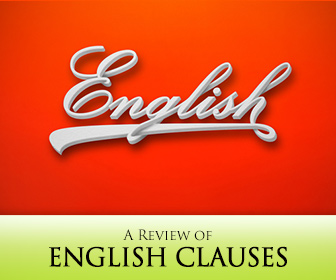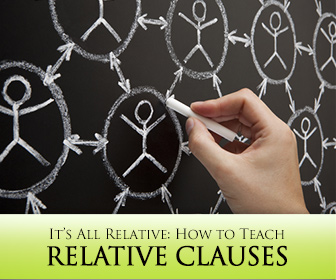Not All Clauses Are Created Equal: A Review of English Clauses


They are not the most simple English grammatical construction, and most students don’t tackle them until they are advanced in their English studies. Relative clauses, however, shouldn’t be left to the very end of a student’s grammar curriculum. They are useful and helpful for students who still have a lot to learn when it comes to English, and these dependent clauses don’t have to be that complicated.

Relative clauses are sometimes called adjective clauses and follow the noun which they describe. They are dependent clauses which give additional information about a noun in the main clause, and the follow that noun in the complex sentence they create. Dependent clauses start with a relative pronoun: that, which, where, when, who, and whom (though whom has fallen out of everyday use and often sounds overly formal when used). Whose is also used as a relative pronoun but must be followed by a noun in the dependent clause. The correct relative pronoun depends on what noun the relative clause describes.
The easiest way to teach relative clauses to your ESL students is to start with two simple sentences, two independent clauses, which contain the same noun. For example,
These are grammatically correct sentences, but they aren’t very interesting or very realistic for fluent speech. The best strategy, then, is to combine them to make one more interesting and complex sentence. “The boy” is a noun which appears in both sentences, so we can use a relative clause to combine these two simple sentences into one complex sentences. First, help your students form the dependent clause. Start by replacing the noun in one of the sentences with the appropriate relative pronoun. In this case, the boy is the subject of the sentence and is a person, so we will replace it with “who” to form the relative clause.
We now have a simple sentence and a relative clause. All that remains is to position the relative clause after the noun it describes in the main sentence (independent clause).
We have the same information in this one sentence as we had in the two original simple sentences. The complex sentence, however, is more natural sounding and more interesting.
Relative clauses don’t have to describe the subject of a main clause. We can formulate effective descriptive clauses for nouns which act in different positions of a sentence. In the following sentence, the book is in the object position in both simple sentences.
In these sentences, “the book” is the noun which appears in both sentences, and since it is a thing we will use the relative pronoun “that” in the relative clause.
If we were to combine these clauses as is, we would find that the resulting sentence is ungrammatical and makes little sense. (I saw the book the boy had that.) Because the noun in the relative clause is in the object position, we must take one more step before combining the clauses into a correct complex sentence. We must first move the relative pronoun to the beginning of the clause, and then we can combine the clauses to make a complex sentence.
We then place the relative clause after the noun in the simple sentence to form the complex sentence.
In the two examples we have looked at so far, the relative clauses were used to identify the nouns in the sentence. In other words, we could have been talking about any boy or any book. The information in the relative clause helps identify exactly which boy or which book we are talking about. Because of this, these clauses are called restrictive relative clauses. But not all relative clauses are used to identify a generic noun. Sometimes, the information in the main clause alone is enough to identify it, and the relative clause simply gives additional information about that noun. Take the following examples.
Because we have his name in the first sentence, we know who John Milton is. The fact that he is the speaker’s favorite author is additional information. We do not need it to identify John Milton. We can still rewrite the second sentence as a relative clause. We follow the same process as in the examples above, but in this case we have one more thing to talk about: punctuation.
This time, the relative clause is offset by commas because it is extra information; it is not necessary to identify the noun in question. Students often get confused when to use commas and when not to when it comes to relative clauses. Simply put, if the relative clause identifies a generic noun, do not use commas. When the relative clause gives extra information about the noun, offset it with commas. These are known as non-restrictive relative clauses.
What is that word that is like a television but just sound? A radio. What is an encyclopedia? It is a book that gives information on many different topics. Why does any of this matter? Because these exchanges use relative clauses to overcome communication barriers.
Relative clauses are an extremely useful structure for ESL students to learn early in their English studies. They may not make for the most simple grammar lesson, but they are infinitely practical for students who are still learning. ESL students will find two situations in which relative clauses help them communicate. First, your ESL students may find that they do not know a particular piece of vocabulary for a word they are trying to say. In this case, the relative clause can provide the definition even when students don’t know the word and thus help the listener to understand the speaker’s meaning.
Most listeners would have little problem understanding that the remote was lost. Using this structure, ESL students can reference any object even if they do not know the specific vocabulary word for it.
In addition, relative clauses can help your students understand the meaning of unfamiliar words they come across. When a nonnative speaker asks what a particular word is/means, she will very likely receive a definition using a relative clause.
Though the language learner may not have known the meaning of astronaut or sorbet, they can understand the explanation if they know how to use relative clauses.
They will be able to successfully communicate even when they lack the vocabulary to communicate straightforwardly. Though they may be a somewhat complex grammatical structure, relative clauses are key to being understood and understanding others for ESL students.
At what point do you teach relative clauses to your ESL students?